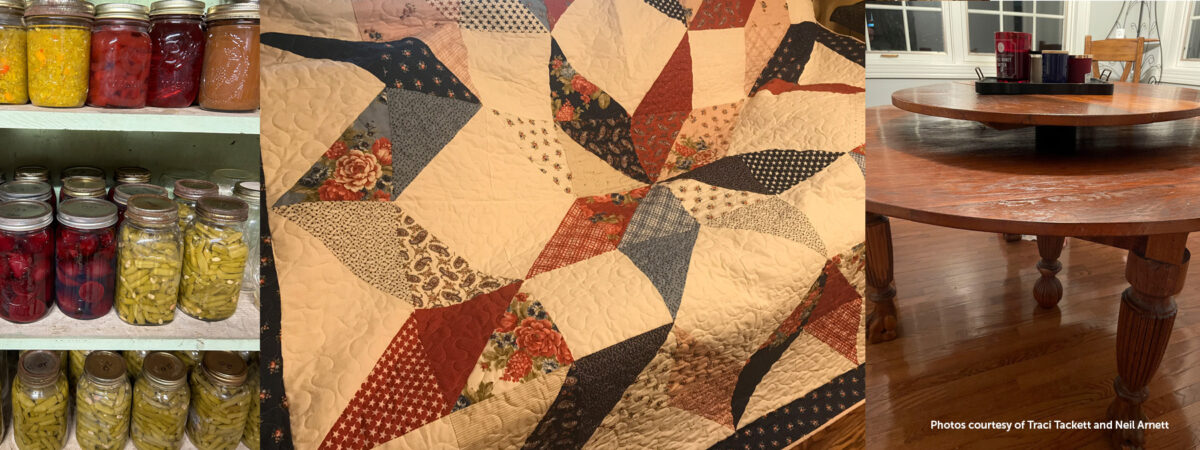

Mary Slone sharing her object that represents Appalachian Ingenuity
Photo credit: Neil Arnett
As an educator and participant at this recent training, I was able to join in on a day of storytelling, imagining the future, and considering the importance of storytelling in the classroom, especially when connecting project-based learning to the community. Sam, an MIT graduate and grandson of Beulah, asked each participant to bring a physical object (or a picture) from our family that represents Appalachian Ingenuity, or problem-solving and innovation in our culture. One by one, each participant shared the object and the story behind it.
From brown-bag faux hornet’s nest to quilts to modified lawnmowers, each story was a reminder that I, along with my peers, have borne witness and been impacted by makers–people who live on the edge of disruption and choose to use it as an agent.

A faux hornet’s nest that deters insects – an object shared by one of the teachers during the training
Photo Credit: Traci Tackett
While I have always loved and respected my grandmother, Norma Lou Turner, it was revelatory to view her from this lens. Not only was she resilient, a quality Sam described as defensive, but she was also regenerative, a quality he described as being on the offensive. To share with others what my mamaw did with the resources that helped her and her family to thrive, ignited something inside of me. Something that reminded me who I was and why I was.
Isn’t that what we want for our students? To be people who confront challenges head-on and utilize whatever resources are available. Unfortunately, many young people (and even their teachers) can be mired by a malaise. During the training, Sam shared an exchange he had when someone asked, “Why is there so much pessimism in regards to the future?” Sam replied, sharing that it is hard to be excited for a future when you cannot imagine yourself in it. This deceptively simple premise of connecting young people with their past empowers them to believe in what is possible.

An example of an object representing Appalachian Ingenuity that uses everyday objects to solve challenges
Photo Credit: Jennifer Stewart
During Civic Imagination Project’s training, we were placed in two groups with the charge to brainstorm how using storytelling as a foundation can inspire project-based learning. One science teacher began to envision students identifying problems in their community. An invigorating discussion ensued about the potency of that skill alone–the ability to identify a problem is the first step in students being able to actually imagine the future because they have the agency to be active members of their community. Spurred by the realization that they would be responsible for something with real-world impact, the science teacher began to anticipate the process her students could follow and the science they could use to become makers themselves.
Weeks after this experience I still get energized by the sheer possibility of it all. Like Dorothy after her return to Kansas, I was reminded of the power found in my literal, and figurative, backyard.
I am excited to explore what it could mean to be a novice historian who examines the future by filling myself with the past and inviting my students to do the same.
Learn more about the Drawing on Kinship: Rurally Sustaining Computational Thinking Pathways project and follow and support us on this journey with #CTKinship. Learn more about the Civic Imagination Project at USC and efforts to unleash the potential of Kentucky’s innovators and entrepreneurs.
This Civic Imagination Project training led by Sam Ford on February 20 included a virtual discussion session with Civic Imagination Project co-founder Dr. Sangita Shresthova at the University of Southern California (USC). It is one of several Kentucky-based projects on civic imagination that Ford and Shresthova have collaborated on, including their formative 2017 Future of Work in Kentucky session and their current Civic Imagination incubator for storytellers at Western Kentucky University, a partnership with the USC group and AccelerateKY. AccelerateKY was formed as a partnership between Kentucky innovators and labs at MIT and is a core partner in the Drawing on Kinship Project.
This material is based upon work supported by the National Science Foundation under Grant No. 2219401. Any opinions, findings, and conclusions or recommendations expressed in this material are those of the author(s) and do not necessarily reflect the views of the National Science Foundation.